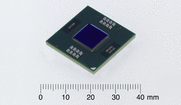malware
New Member
- Joined
- Nov 7, 2004
- Messages
- 5,422 (0.72/day)
- Location
- Bulgaria
| Processor | Intel Core 2 Quad Q6600 G0 VID: 1.2125 |
|---|---|
| Motherboard | GIGABYTE GA-P35-DS3P rev.2.0 |
| Cooling | Thermalright Ultra-120 eXtreme + Noctua NF-S12 Fan |
| Memory | 4x1 GB PQI DDR2 PC2-6400 |
| Video Card(s) | Colorful iGame Radeon HD 4890 1 GB GDDR5 |
| Storage | 2x 500 GB Seagate Barracuda 7200.11 32 MB RAID0 |
| Display(s) | BenQ G2400W 24-inch WideScreen LCD |
| Case | Cooler Master COSMOS RC-1000 (sold), Cooler Master HAF-932 (delivered) |
| Audio Device(s) | Creative X-Fi XtremeMusic + Logitech Z-5500 Digital THX |
| Power Supply | Chieftec CFT-1000G-DF 1kW |
| Software | Laptop: Lenovo 3000 N200 C2DT2310/3GB/120GB/GF7300/15.4"/Razer |
Toshiba Corporation today announced the start of sample shipping of the SpursEngine SE1000 (SpursEngine), a high-performance stream processor integrating four Synergistic Processing Element (SPE) cores derived from the "Cell Broadband Engine" (Cell/B.E.). Sample shipping started from today, and Toshiba expects sales of 6 million units within the first three years of the SpursEngine's release.


SpursEngine is a co-processor that integrates a hardware codec for Full HD encoding and decoding of MPEG-2 and H.264 streams with four SPEs derived from Cell/B.E. These advanced processing elements offer high performance media streaming capabilities, with a clock frequency of 1.5GHz, while achieving low power consumption range of 10W to 20W.
"We are very pleased to have started sample shipping of SpursEngine" said Yoshio Masubuchi, Director of Toshiba's System LSI Division, Advanced SoC Development Center. "The design of this powerful co-processor is dedicated to bringing the advanced capabilities of the Cell/B.E. to consumer electronics, particularly video processing in digital consumer products. We are sure that SpursEngine will accelerate the market for full-HD applications."
Toshiba will support developers working on SpursEngine applications with a comprehensive reference kit that includes a reference board and essential middleware APIs. The reference board has a PCI-Express edge connector that can connect to an x1 layer slot in a PC. Toshiba will also provide an integrated development environment (SPE compiler, SPE debugger, and performance monitor) and sample applications that demonstrate how to use the provided middleware. With the reference kit, customers can quickly and easily construct an evaluation and development environment and accelerate product development.
Toshiba will further boost the performance and cut the power consumption of the SpursEngine, towards supporting further innovation in products offering new levels of functionality.
Co-operation between Toshiba and the SpursEngine SE1000 Partnerships
Toshiba is developing co-operative relationships with many partner companies in order to develop wide scope video solutions that utilize SpursEngine. For example, we are partnering with Corel Corporation whose headquarters are in Canada; and Taiwan based CyberLink Corporation and Leadtek Research Inc. These companies produce popular video and image processing software and hardware such as graphic board, and will together supply to set manufactures. By working together with these companies and creating a new value chain, many end user can enjoy comfortable digital life by using our board and software bundled with SpursEngine.
View at TechPowerUp Main Site


SpursEngine is a co-processor that integrates a hardware codec for Full HD encoding and decoding of MPEG-2 and H.264 streams with four SPEs derived from Cell/B.E. These advanced processing elements offer high performance media streaming capabilities, with a clock frequency of 1.5GHz, while achieving low power consumption range of 10W to 20W.
"We are very pleased to have started sample shipping of SpursEngine" said Yoshio Masubuchi, Director of Toshiba's System LSI Division, Advanced SoC Development Center. "The design of this powerful co-processor is dedicated to bringing the advanced capabilities of the Cell/B.E. to consumer electronics, particularly video processing in digital consumer products. We are sure that SpursEngine will accelerate the market for full-HD applications."
Toshiba will support developers working on SpursEngine applications with a comprehensive reference kit that includes a reference board and essential middleware APIs. The reference board has a PCI-Express edge connector that can connect to an x1 layer slot in a PC. Toshiba will also provide an integrated development environment (SPE compiler, SPE debugger, and performance monitor) and sample applications that demonstrate how to use the provided middleware. With the reference kit, customers can quickly and easily construct an evaluation and development environment and accelerate product development.
Toshiba will further boost the performance and cut the power consumption of the SpursEngine, towards supporting further innovation in products offering new levels of functionality.
Co-operation between Toshiba and the SpursEngine SE1000 Partnerships
Toshiba is developing co-operative relationships with many partner companies in order to develop wide scope video solutions that utilize SpursEngine. For example, we are partnering with Corel Corporation whose headquarters are in Canada; and Taiwan based CyberLink Corporation and Leadtek Research Inc. These companies produce popular video and image processing software and hardware such as graphic board, and will together supply to set manufactures. By working together with these companies and creating a new value chain, many end user can enjoy comfortable digital life by using our board and software bundled with SpursEngine.
View at TechPowerUp Main Site




 so....
so....

